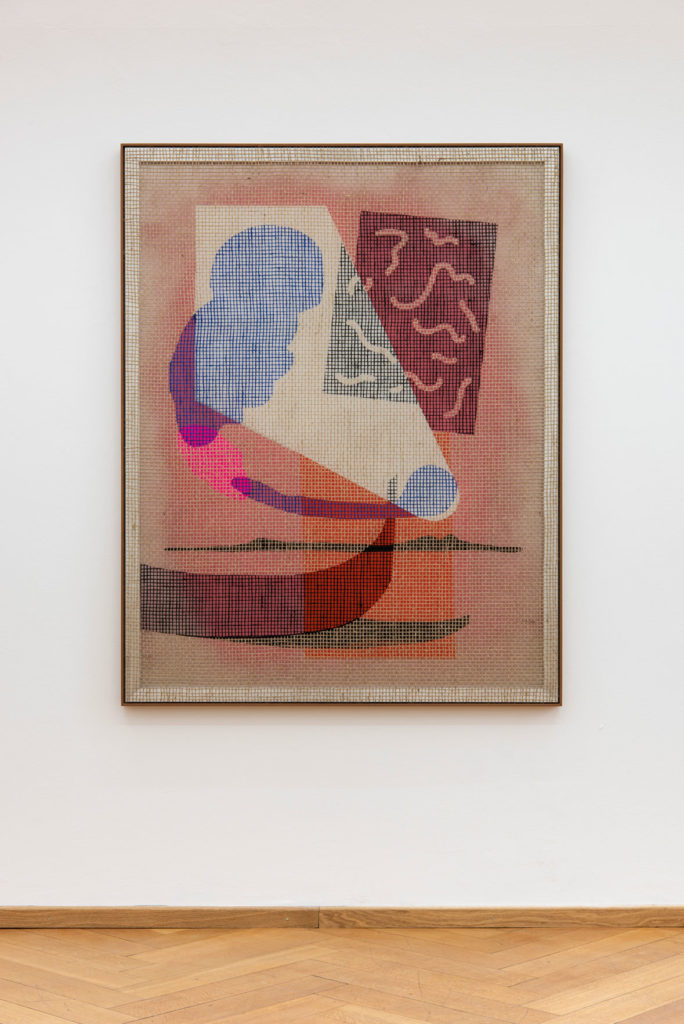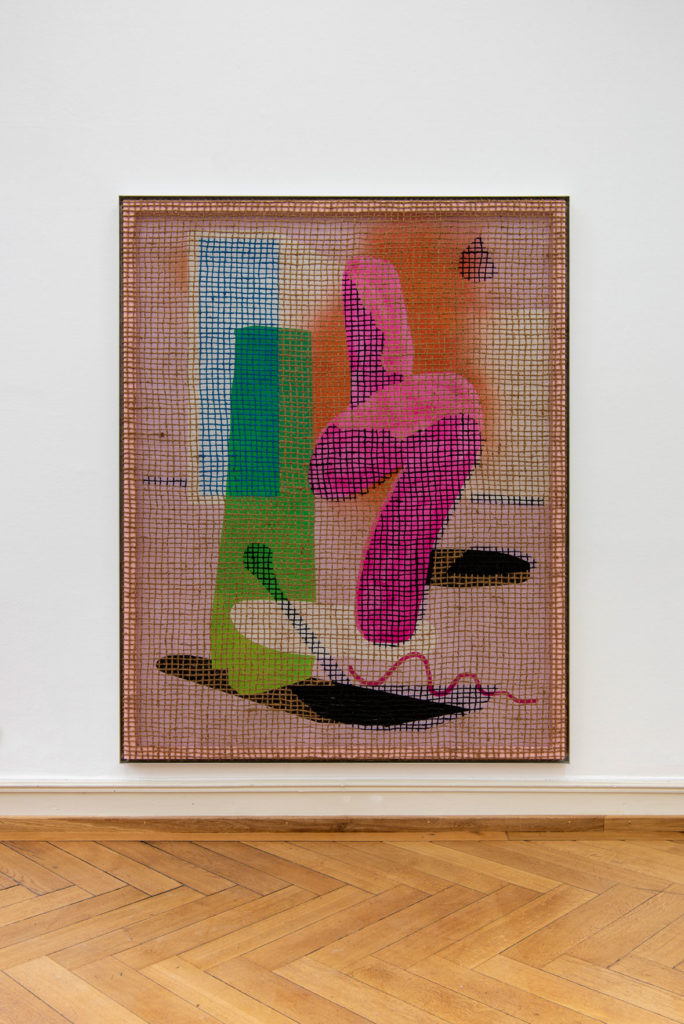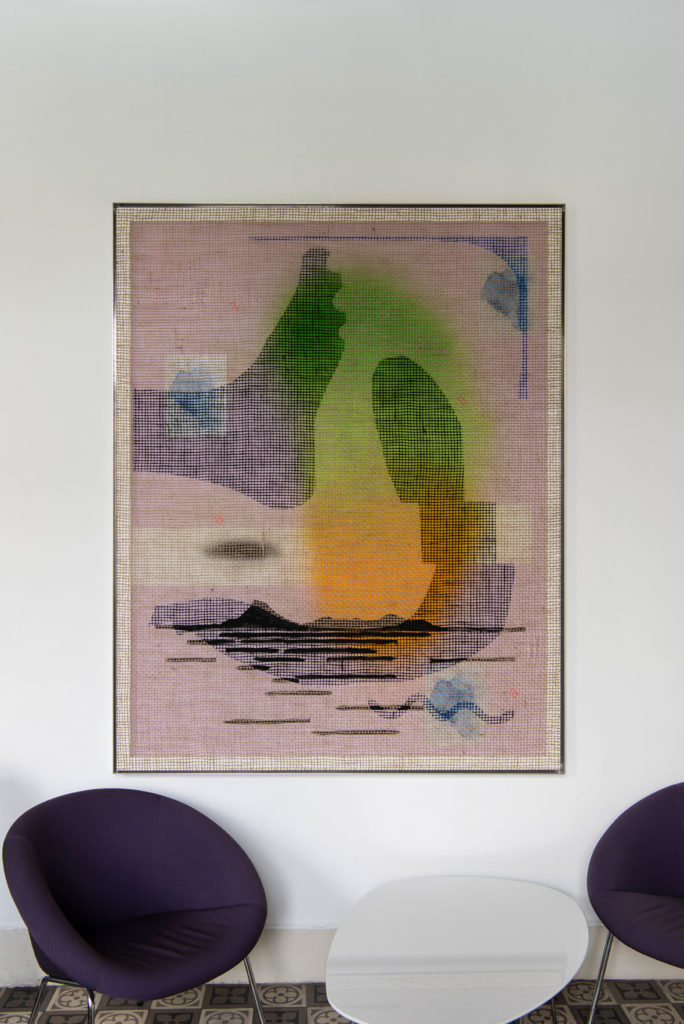Desire Paintings
PLEASE SCROLL DOWN FOR ENGLISH VERSION
Und gibt es solche Schnörkel-Signaturen, die den Spell my name betitelten Skulpturen ähneln, nicht auch in den Desire Paintings? In diesen wird die klassische Betrachtungshaltung vor Malerei auf eine Probe gestellt, ist ihre Wahrnehmung doch sehr prozessual angelegt und verschieben sich dabei bei jeder eigenen Bewegung die zu konstatierenden bildlichen Verhältnisse. Der „perfekte“ Standort vor einem der Desire Paintings weicht bisweilen ab von der Position, die man vor „klassischer“ Malerei einzunehmen gewohnt ist. Erst aus einer „falschen“ Position heraus, etwa schräg von der Seite her, fügen sich die Elemente im Bild und es gelangen beispielsweise eine Form und ihre Schattenform zu einer stimmigen Deckung. Frontal zeigen sich David Rengglis Werke wie Gemälde auf Leinwand in extremer Nahsicht, als erschiene nun die Körnung, die Bindung des Stoffes in Form der Jutenetze stark vergrößert. Sehr delikat ist die Interaktion der Farben – so changiert augenscheinlich etwa ein durchgängig gleiches Blau, das auf der Ebene eines Jutenetzes liegt, in Korrespondenz und Abhängigkeit der auf der Rahmenunterseite liegenden Farbformen. Mal spielt es in Richtung Leuchtendblau, dann macht es einen glauben, das Blau hätte einen violetten Einschlag…

Desire Painting, 2020, Acryl auf Holz und Jute-Netz, 250 x 195 cm 
Desire Painting: Mezzo Mezzo Gio, 2019, Acryl auf Aluminium und Jute-Netz, Holzrahmen, 160 x 125 x 5 cm, Privatsammlung 
Desire Painting, 2020, Acryl auf Holz und Jute-Netz, 190 x 150 cm und
Insta Cat, 2020, Acrystal, ca. 30 x 20 x 25 cm
Desire Painting: Sculpturiana, 2018, Acryl auf Holz und Jute-Netz, 215 x 170 cm,
Courtesy Wentrup Gallery, Berlin
Desire Painting, (No Wish co Cry), 2018, Acryl auf Holz und Jute-Netz, 192,7 x 152,7 cm
And in the Desire Paintings as well, are there not curved signatures which resemble the sculptures bearing the title Spell my name? Here the classical attitude of the viewer with regard to painting is put to the test, inasmuch as the perception of these works acquires a processual dimension: the ascertained pictorial relationships shift with each movement of the individual viewer. The ‘perfect’ point of view in front of one of the Desire Paintings sometimes diverges from the position which one is accustomed to occupy vis-à-vis ‘classic’ paintings. It is only from a ‘false’ position – for instance, diagonally from the side – that the elements conjoin in the picture in such a way that, for example, a form and its shadow-shape come to convey a coherent covering. From a frontal perspective, David Renggli’s works resemble paintings on canvas which are examined in extreme close-up, as if the granularity and the bonding of the material in the form of jute netting were to appear greatly enlarged. The interaction between the colours is extremely delicate: for example, a consistently uniform blue lying on the level of a jute mesh apparently oscillates in correspondence with and dependency on the coloured forms situated upon the underside of the frame. Sometimes the colouration tends towards a radiant blue, only to subsequently convey the impression that the blue has acquired a violet hue …
